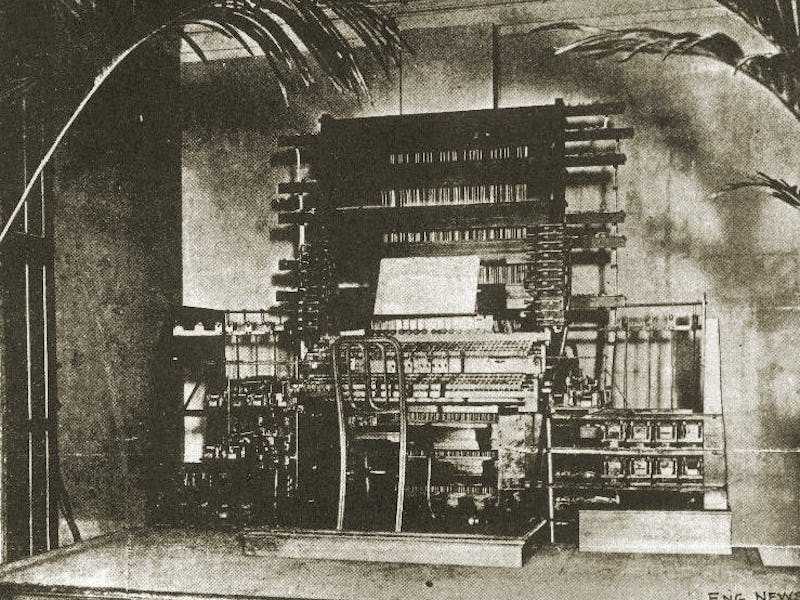Thaddeus Cahill's Telharmonium: The World's First Electronic Synthsizer
Thaddeus Cahill's quest to create the world's first streaming music service with the help of his proto synthesizer.

In 1893, a Washington D.C. lawyer and amateur inventor had a peculiar and particular vision: to create a service that streamed live music into restaurants, hotels, or even your Aunt Edith’s tea room. Thaddeus Cahill’s initial idea was fairly simple. From a central studio, he’d have bands play around the clock, and those sounds would then be transmitted using the most cutting edge technology of the time — telephone lines.
His method was, in a way, prescient. Sending a current through a dynamo did amplify sound. However, it was the sound being amplified that caught Cahill by surprise: the dynamo itself created its own very distinct (and overpowering) tone. Switching the frequencies of the dynamo changed the pitch, and Cahill realized that with the proper tweaks, he could replicate just about any note in any audible octave. With 12 cylinders — one spinning at the frequency corresponding to a note on the chromatic scale — each equipped with a series of tone wheels, Cahill discovered he could bend the frequencies in such a way that he could produce 12 notes within each of five octave ranges.
One small hitch: Telephones of the time were adequate for transmitting mouth-to-ear, but there was no way to produce electric sounds loud enough to fill a ballroom, or for that matter, even a modest sitting room. Undeterred, Cahill began experimenting with ways to amplify electric signals over the phone line; by his reckoning, more power meant a stronger signal, which would in turn mean more sound out of the receiver.
Not only that, but with a little extra tweaking those tone wheels could be used to change tone as well as pitch. (Pitch changes notes, tone is what makes the same note sound different on different instruments). By the time he was finished, Cahill had constructed a fully functional synthesizer. Not only could the operator play the right notes on demand by pressing buttons on a touch-sensitive keypad, but it had built-in settings to emulate various instruments. Need a piano? Pull the piano lever. Oboe? Give that clearly marked oboe lever a little tug. By the time he was finished, his new telharmonium could emulate an entire symphony’s worth of instruments.
While his new telharmonium (the cool kids called it a dynamophone) made sounds that transmitted much more clearly over telephone lines than conventional instruments, there was still the issue of creating enough power to fill a room. Sticking with his very simply theory of more power equals more sound, Cahill’s first prototype contained 35 enormous generators, which was just enough to stream a synthesized rendition of Handel’s Largo from his workshop in Washington to investors at a fundraising dinner in Maryland.
One Telharmonium tone wheel
Investors were so impressed they competed to fund Cahill’s streaming synthesized music service. After acquiring a whopping $200,000 in investment capital (roughly $4,000,000 in today’s money), Cahill’s final version of the telharmonium contained 145 modified dynamos that could produce 36 notes across seven octaves. At 60 feet long, weighing over 2,000 tons, the mack daddy dynamophone required a minimum of two players operating more than 2,000 buttons, levers, and switches.
Cahill’s telharmonium was a technical marvel as a synthesizer. Unfortunately for ol’ Thad, there were three main hitches in his giddy-up. First, even with a small city’s worth of power generators attached to the machine, there simply wasn’t enough amplification to produce the sound clearly or loudly enough on the scale Cahill envisioned; the best amplifiers of the day were literally large paper cones.
Second, conducting entire symphonies over telephone lines is cool as long as no one else actually wants to use those particular phone lines to talk. After Cahill moved the machine to the Broadway building in New York, neighbors weren’t too thrilled at picking up the phone only to find they would have to scream over electric concertos.
Finally, Thad had the misfortune of creating his telephone-based music service at exactly the same time two chaps named Nikola Tesla and Guglielmo Marconi were competing to create and perfect wireless radio technology. Given the choice, music fans preferred to hear actual symphonies over the wireless more than Cahill’s synthesized masterpieces every time they lifted their phone receivers.
Cahill’s version of a paid streaming music service was a flop, but within the next 20 years, his vision of instrumental music broadcast into hotel lobbies, elevators, and department stores would indeed become a reality.
And while the world in 1906 wasn’t quite ready to accept electronic music as much more than a novelty, Cahill’s telharmonium was the grandaddy of synthesized music. With the advent of the amplifier, Laurens Hammond and John M. Hanert were able to replicate Cahill’s technology on a much smaller scale to create the Hammond organ, which would eventually pave the way for just about every electric organ, synth, and oh yes, keytar that followed. Cahill phoned pre-radio America, and the future eventually got the voicemail.